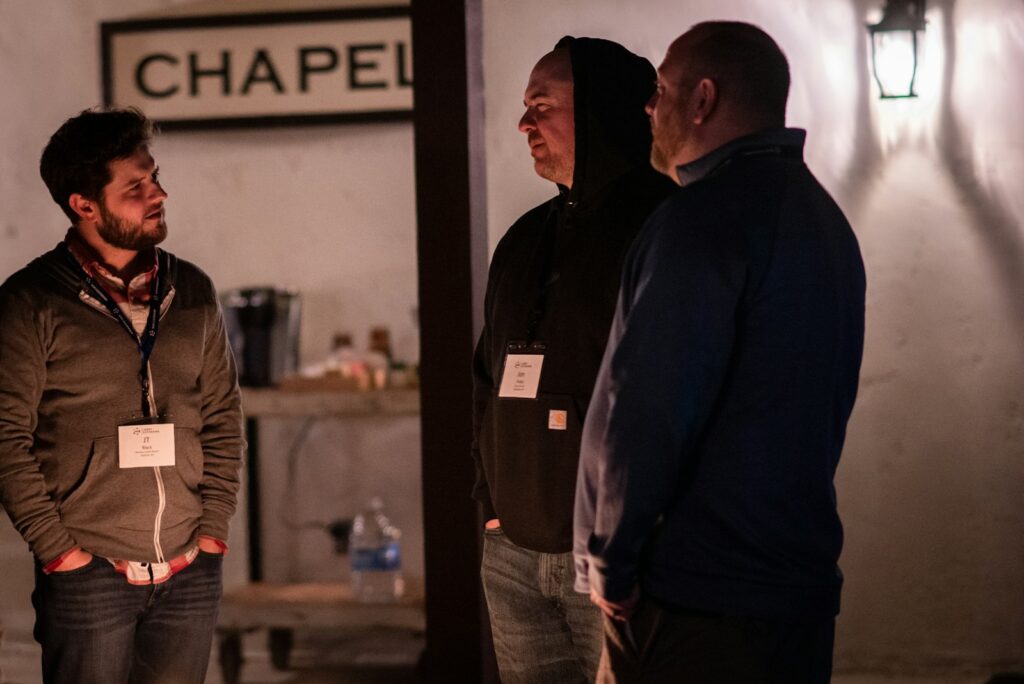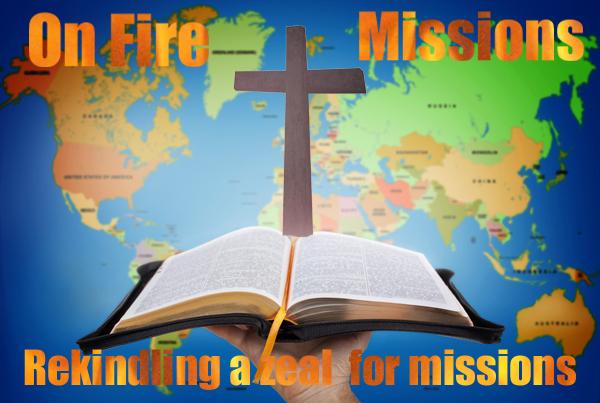

A disciple in the Bible is a “learner” or “student” who is taught by a teacher. Making disciples involves the person-to-person living of life together in which younger Christians are taught by more mature Christians. The process is similar to the way that an apprentice learns a skill by direct observation of, and involvement with, the master craftsman.
In the New Testament, Paul says to the Corinthians that they may have many “guides” (or “teachers”) but that Paul was their spiritual “father” (1 Corinthians 4:15). Paul laid the foundation and others were building on that foundation as guides and teachers (1 Corinthians 3:10) in the process of discipleship.
The objective of the disciple, according to Mathew 28:20, is to teach the new believer to obey all that Jesus has commanded. This is intended to be a multiplicative process, where disciples go on to disciple others, as Paul instructed Timothy:
“…what you have heard from me in the presence of many witnesses entrust to faithful men who will be able to teach others also.”
—2 Timothy 2:2
This takes time and perseverance, and there is no substitute for the personal, relational aspect of it. The rise of the Internet and mobile phones does not mean that we can now stay home and make disciples over Skype. Tools such as these are useful in many aspects of equipping the global Church to grow spiritually as disciples of Christ. But they are not replacements for the mandate to “Go” and live incarnationally among least-reached people groups, testifying of the risen Christ, and living out God’s love to them in tangible ways.
One of the most helpful stories in the Bible for understanding Biblical discipleship is the story of Ezra. The Babylonians had defeated the kingdom of Judah 140 years before, but now, finally the walls of Jerusalem had been rebuilt and some of the exiles had returned. All the people in Jerusalem gathered into the square and Ezra, together with the other leaders, read to the people from the Law.
They read out of the book of the law of God, translating and giving the meaning so that the people could understand what was read.
—Nehemiah 8:8
Note some key aspects of Ezra’s approach: it was centered on the Word of God, translated into the language of the hearers, commu – nicated orally, and explained so they could understand it.
The Word of God Is the Foundation for Discipleship
Ezra knew that God’s Word is the only basis for truth and spiritual instruction. The purpose for his return to Jerusalem was to teach God’s Word to the people:
Now Ezra had determined in his heart to study the law of the LORD, obey it, and teach its statutes and ordinances in Israel.
—Ezra 7:10
As with Ezra thousands of years ago, so it is today. The teaching of the Word of God is the foundational aspect of “making disciples of all nations.” The end-goal of world missions is disciples of Christ in every language and people group—disciples who are spiritually complete and equipped to equip others. Apart from the Word of God, this cannot happen.
All Scripture is breathed out by God and profitable for teaching, for reproof, for correction, and for training in righteousness, that the man of God may be complete, equipped for every good work.
—2 Timothy 3:16-17
It is no surprise, then, that the greatest felt need of new believers in any people group is to learn the Word of God. David Platt tells the story of meeting with believers in a country where it is illegal for Christians to gather. He had to wear dark clothes and they smuggled him into the village in the dead of night. Finally, he arrived at the house where Christian brothers and sisters were waiting to be taught from the Bible. These believers were so hungry for God’s Word they asked him to teach them about all the books of the Old Testament, though he only had limited time with them. “We will do whatever it takes,” they said. “Most of us are farmers, and we worked all day, but we will leave our fields unattended for the next couple of weeks if we can learn the Old Testament.”4 So they studied the Old Testament and then, on the last day he was with them, did a twelve-hour study of the entire New Testament as well.
More than anything else, disciples of Christ need the Word of God. But the Bible is not magic. It is “living and active, sharper than any two-edged sword” (Hebrews 4:12, ESV) when it is understood, at both the cognitive and spiritual level. Often, the Holy Spirit uses people as teachers and disciples to help the human mind comprehend the Word of God. In Acts 8:26-40, we see that the Ethiopian eunuch was reading the Word of God, but unable to understand what he was reading. After Philip helped him understand the Word of God, it brought about change in the life of the Ethiopian. He believed, was baptized, and went on his way rejoicing.
In order for there to be understanding, it is important that the Word of God be translated into the language the hearers know best and that communicates most deeply to them—their “heart language.” The heart language is the vehicle through which the Word of God brings about real and lasting change at a deep, worldview-altering level.
The Word of God, Translated
When Ezra read aloud from the Word of God (Nehemiah 8:8), he made every effort to enable the people to clearly understand what was read. The exact details of how he and the Levites did this, especially to a crowd that may have numbered nearly 50,000 people (Nehemiah 7:66-67), is not stated in the narrative. Many of the people in that gathering had been raised in exile and probably spoke Aramaic as their heart language. Because of this, the Law, written in Hebrew, may not have been understandable to them without translation. So it is likely that part of the communication process used by Ezra and the Levites involved translation of the Law from Hebrew to Aramaic so that everyone could understand. The result of this clear communication of the Word of God in the language of the hearers went far beyond mere intellectual assent. It cut all the way to their hearts:
Nehemiah the governor, Ezra the priest and scribe, and the Levites who were instructing the people said to all of them, “This day is holy to the LORD your God. Do not mourn or weep.” For all the people were weeping as they heard the words of the law.
—Nehemiah 8:9, emphasis added
The people heard the Word of God and understood it, not just academically, but at an emotional, life-changing level. This pattern repeats itself all over the world. When the Word of God is communicated in a trade language or language of wider communication, there may be some life change and spiritual awakening in some people. But a worldview-altering, people group-awakening “heart change” that lasts most readily occurs when the Word of God is communicated in the heart language of the hearers.
The story of the translation of the Bible into the Kabuverdianu language of the Cape Verde islands is a classic example of the kind of impact the Word of God in the heart language can have.5 The Kabuverdianu translation team had completed a draft of the first chapters of Luke and had given it to the pastor to review. On the first Sunday in December, the pastor started his sermon by announcing the reading from God’s Word. But instead of reading from the Bible in the national language, Portuguese, he read from the verses that had been translated into Kabuverdianu.
“Our reading will be from Luke 2, verses 1 through 7,” he announced.
As the congregation listened intently, he read the passage.
Pausing, he exclaimed, “It tastes so good, it tastes so good!” Then he started reading again and didn’t stop until he’d finished the entire chapter, reading with the confidence and expression of someone who understood and cherished every word.
The translation team began to sob. A row of teenage girls stared at each other in wide-eyed wonder and then dissolved into a group hug. Eyes glistened with tears. As the last word was read, a spontaneous cheer erupted: “Amen! Hallelujah!” The service closed with many hugs for those who had worked on the translation.
A woman who had been educated in Portuguese had started to follow along in her Portuguese Bible, but then stopped and just listened to the Word of God in her language.
“I let the words fall over me,” she said. “For the first time in my life I felt washed by the Word. I thought I knew the Christmas story by heart, but I must confess that today I feel like I’ve heard it for the very first time.”
It is clear that part of the process of “making disciples of all nations” must include the translation of the Bible into the languages that are spoken by these people groups. But merely translating the Bible as a written text is not sufficient for people groups who are primarily oral (not text-based) in their means of communication.
The Word of God, Heard
The Bible tells us that “faith comes from hearing, and hearing through the word of Christ” (Romans 10:17, ESV). When Ezra instructed the people from the Word of God, he did so out loud, speaking to them the Word of God. Jesus also used an oral approach when he taught his disciples, frequently using stories as the means of teaching:
“He taught them by telling many stories in the form of parables…”
—Mark 4:2, NLT
The significance of this should not be missed. Hearing the Word of God results in faith. The oral communication of the Word of God also removes the need for literacy as a prerequisite for ingesting and comprehending the Word of God in oral communities. This is significant because, according to missiologists in the International Orality Network, oral communicators are found in every cultural group in the world, and they constitute approximately two-thirds of the world’s population.[1]
Traditionally, however, the process of “making disciples” cross-culturally has tended to use text-based, linear teaching approaches that are usually encountered in academic environments. These teaching materials and techniques are usually not well-suited for oral patterns of communication. These patterns often include the telling of stories, drama, song and dance, and are used in most people groups around the world. As a result of the disconnect between a text-based means of communication and a people group that communicates orally, comprehension of the content by the target audience is often very limited.
The effectiveness of using oral strategies among people who are oral communicators is illustrated in the story of a pastor in India who came to Christ through the work of a cross-cultural mission- ary.[2] He went to a Bible college where he received two years of theological training, after which he returned to his village to preach the Gospel.
But not all went according to plan. “To my surprise,” he said, “my people were not able to understand my message. A few people accepted the Lord after much labour. I continued to preach the gospel, but there were little results. I was discouraged and confused and did not know what to do.”
Then he attended a seminar where he learned how to communicate the Gospel using oral methods. At this point, he realized that his problem was that the communication style he had been using was
based on lecture methods with printed books, like he had learned at the Bible college. He returned to the village and started using oral methods to communicate the Gospel, and the people were more responsive:
After the seminar I went to the village, but this time I changed my way of communication. I started using a storytelling method in my native language. I used gospel songs and the traditional music of my people. This time the people in the villages began to understand the gospel in a better way. As a result of it, people began to come in large numbers. Many accepted Christ and took baptism.
The prevalence of oral communicators in the world does not mean the printed Word of God or other text-based materials are obsolete and no longer of use. On the contrary, they will continue to be foundational to the task of making disciples. But effective discipleship strategies among least-reached people groups also take into account the reality that most people in the world will best learn to become disciples of Christ through primarily oral means.[3]
So we see that the Word of God must be translated for effective use and also made accessible to oral communicators. But “making disciples of all nations” also includes explaining the Word of God and contextualizing the message for accurate communication within the culture of the disciple.
The Word of God, Explained
In addition to communicating the translated Word of God orally, Ezra and the Levites “gave the meaning” of what was read. The Law was originally given by God directly to the Jewish people, written in Hebrew and applied directly to their culture. But for many in Ezra’s time, this may have been the first time they had heard the Law. Others may have heard the Law many times, but they needed it explained and applied to their context. Nearly a thousand years had passed since the giving of the Law, and much had changed in the daily lives of the Jewish people. Even though the Law had been written to them, it was important for it to be explained and the meaning clearly communicated in order for the people to understand it.
The cultures of the vast majority of the people groups in the world are far removed from the Jewish and Greco-Roman cultures of the original audiences of the Old and New Testaments. In addition, the languages spoken today by these thousands of people groups are usually very linguistically different from the Hebrew language of the Old Testament and Greek of the New Testament. The more distinct the culture and language of a people group are from the culture and language of the original audience of the Bible, the more likely the need for explanation of what is written in the Bible, to bridge the gap between the two contexts.
Consider, for example, the challenge in communicating crucial Biblical themes like “eternal life”, “faith”, “forgiveness”, “sin”, and “mercy” in cultures where such concepts are unheard of, and in languages for which there is no vocabulary to describe them? How do you explain the significance of John’s statement regarding Jesus: “Here is the Lamb of God, who takes away the sin of the world” (John 1:29) in a culture that does not have sheep or a sacrificial system? If you have never heard of the Romans, or that they occupied Judah many years ago, or that during that time a Roman soldier could require anyone to carry loads for them, how will you understand the signifi –
cance of Jesus’ audacious statement, “If anyone forces you to go one mile, go with him two” (Matthew 5:41)?
Additionally, certain aspects of the culture and language of the original audiences of the Scripture were implicitly understood by them, even though they are not explicitly stated in the Biblical texts. The absence of this implicitly understood information can create confusion or misunderstanding for people in other cultures who are not aware of the differences between the contexts of the original audience and their own.
Bruce Olson, in the book Bruchko, tells of challenges he faced when communicating the stories of the Bible to the Motilone people in the Amazon jungle. One story, the parable of the wise man who built his house on the rock, was especially problematic. In the story, Jesus says, “Everyone then who hears these words of mine and does them will be like a wise man who built his house on the rock” (Matthew 7:24, ESV). But this created such problems that Bruce’s friend and language helper at first wanted to skip it.
“That’s not right, Bruchko. A house that is solid must be built on sand. Otherwise the poles won’t go deep enough, and the house will fall apart.”9
In the Motilone context, a direct, word-for-word translation of the parable would have communicated exactly the opposite of what Jesus had communicated to the original hearers. In Jesus’ context, buildings that were built on sand collapsed, so wise men built their houses on rock. In the Motilone context of the Amazon river basin, only a fool would build his house on a rock, because the flooding rivers would wash it away with the first rain. Instead, jungle houses were built on poles that ran deep into the sand where they would be firm and not collapse in any flood.
In the end, they translated the parable with the wise man building his house on the sand, in order to accurately communicate to the Motilone people what Jesus’ story was intended to communicate.
But regardless of how they translated it, the Motilone (and any) disciple of Christ needs to know at least three things in situations like these. They need to know what Christ actually said, what he meant, and why there is a difference between the two.
The Motilone needs to know that Jesus said “everyone… who hears these words of mine and does them will be like a wise man who built his house on the rock [because he is wise and wants his house to stand firm]” (Matthew 7:24). But they also need to know what Jesus actually meant, as it applies in their own context: “everyone. who hears these words of mine and does them will be like a wise man who built his house on the sand [because he is wise and wants his house to stand firm]”). They also need to understand why there is a difference between what Jesus said and how it is accurately communicated in their own culture. In this case, the explanation would describe the different geography, climate, and cultural factors that affected the building of houses in Israel in the 1st century.
Without explaining the context of a Biblical text and matching its intent to the context of the target culture, much of the Bible may be confusing and unclear to disciples of Christ, even though it is translated and accessible to them in their language. This does not in any way imply that the Scriptures alone are inadequate for “life and godliness”—far from it! The Word of God is “living and active”, and it effectively communicates when it is clearly understood by the hearers in any culture and language.
This is why Ezra and the Levites took great care to read the Word of God and provide explanation. This is also why well-prepared sermons that exposit a portion of Scripture carefully draw out the crucial linguistic, historical, and cultural aspects of the text. The goal of good exegesis in the exposition of Scripture is to help the hearer come to a correct understanding of the text as it would have been understood by the original hearers. In this way, the meaning of the text can be accurately and consistently applied to the unique context of the hearer today.
The Christian Commons is made available under a Creative Commons Attribution-ShareAlike 4.0 License
the above text is attributed thechristiancommons.com as the original content, no changes or edits have been made.
[1] Willis and Evans 2007, 3. Some estimates suggest this may be a conservative estimate and put the total number of oral communicators closer to 85% or more of the world’s population.
[2] Ibid, 2-3.
[3] A common concern regarding the “orality” approach in world missions has to do with the potential for degradation of the message through imperfect oral communication. Given the ease with which orally-communicated messages can change, it would seem to suggest that oral approaches might not be reliable for communicating the eternal and unchanging Truth.
This is a valid concern, but it does not take into account the significant advantages that are unique to primarily oral cultures, or the techniques used in reaching oral communicators that mitigate this potential problem. Those of us from literate cultures may assume that everyone else is as dependent on written methods of communication and data transfer as we are. But oral communicators do not have these same dependencies, because of the significant advantages they have in the realm of memory and retaining information.

